
The term dulcimer refers to two families of musical string instruments.

The hammered dulcimer is a percussion-stringed instrument which consists of strings typically stretched over a trapezoidal resonant sound board. The hammered dulcimer is set before the musician, who in more traditional styles may sit cross-legged on the floor, or in a more modern style may stand or sit at a wooden support with legs. The player holds a small spoon-shaped mallet hammer in each hand to strike the strings. The Graeco-Roman word dulcimer derives from the Latin dulcis (sweet) and the Greek melos (song). The dulcimer, in which the strings are beaten with small hammers, originated from the psaltery, in which the strings are plucked.
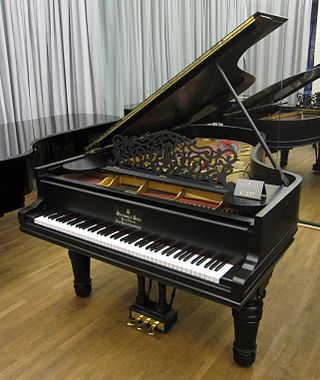
A piano is a keyboard instrument that produces sound when its keys are depressed, activating an action mechanism where hammers strike strings. Modern pianos have a row of 88 black and white keys, tuned to a chromatic scale in equal temperament. A musician who specializes in piano is called a pianist.

In musical instrument classification, string instruments, or chordophones, are musical instruments that produce sound from vibrating strings when a performer strums, plucks, strikes or sounds the strings in varying manners.

The crwth, also called a crowd or rote or crotta, is a bowed lyre, a type of stringed instrument, associated particularly with Welsh music, now archaic but once widely played in Europe. Four historical examples have survived and are to be found in St Fagans National Museum of History (Cardiff); National Library of Wales (Aberystwyth); Warrington Museum & Art Gallery; and the Museum of Fine Arts, Boston (US).

A psaltery is a fretboard-less box zither and is considered the archetype of the zither and dulcimer. Plucked keyboard instruments such as the harpsichord were also inspired by it. Its resonance box is usually trapezoidal, rectangular or in the form of a "pig's head" and often richly decorated.
Piano construction is by now a rather conservative area; most of the technological advances were made by about 1900, and indeed it is possible that some contemporary piano buyers might actually be suspicious of pianos that are made differently from the older kind. Yet piano manufacturers, especially the smaller ones, are still experimenting with ways to build better pianos.
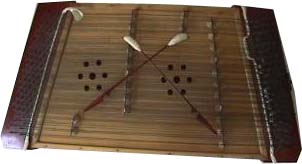
The tsymbaly is the Ukrainian version of the hammer dulcimer. It is a chordophone made up of a trapezoidal box with metal strings strung across it. The tsymbaly is played by striking two beaters against the strings.
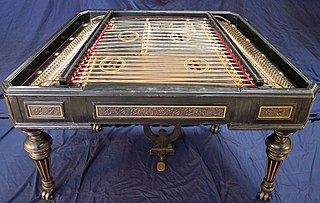
The cimbalom, cimbal or concert cimbalom is a type of chordophone composed of a large, trapezoidal box on legs with metal strings stretched across its top and a damping pedal underneath. It was designed and created by V. Josef Schunda in 1874 in Budapest, based on his modifications to the existing Hammered dulcimer instruments which were already present in Central and Eastern Europe.

The Appalachian dulcimer is a fretted string instrument of the zither family, typically with three or four strings, originally played in the Appalachian region of the United States. The body extends the length of the fingerboard, and its fretting is generally diatonic.

The trapezoidal yangqin is a Chinese hammered dulcimer, likely derived from the Iranian santur or the European dulcimer. It used to be written with the characters 洋琴, but over time the first character changed to 揚, which means "acclaimed". It is also spelled yang ch'in. Hammered dulcimers of various types are now very popular not only in China, but also Eastern Europe, the Middle East, India, Iran, and Pakistan. The instruments are also sometimes known by the names "santoor" and "cymbalom". This instrument had an influence on the Thai classical instrument, known as Khim (ขิม).
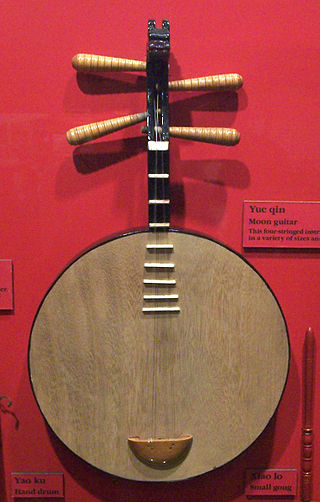
The yueqin, also called a moon lute or moon guitar, is a traditional Chinese string instrument. It is a lute with a round, hollow soundboard, a short fretted neck, and usually four strings. It is an important instrument in the Peking opera orchestra, often taking the role of main melodic instrument in lieu of the bowed string section.
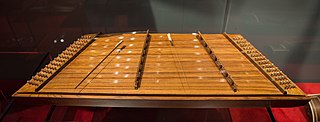
The yanggeum is a traditional Korean string instrument. It is a hammered dulcimer. Unlike other traditional Korean instruments, the yanggeum has metal strings. It is played by striking the strings with a bamboo stick. Yanggeum means a stringed instrument of the West (yang). The yanggeum is also called seoyanggeum or gura cheolsageum. The origin of the yanggeum is based on a South asian instrument called the santoor. The Chinese introduced it into Korea in the 18th century. Its body is flat and trapezoidal, with seven sets of four metal strings. The right hand strikes the strings with a thin bamboo strip.

The tro is Cambodia's traditional spike fiddle, a bowed string instrument that is held and played vertically. Spike fiddles have a handle that passes through the resonator, often forming a spike, on the bottom side where it emerges. The family is similar or distantly related to the Chinese erhu or huqin. The instruments have a soundbox at the bottom of the stick, covered with leather or snake skin. Strings run from pegs at the top of the stick and secured at the bottom, running across the soundbox. The larger the soundbox, the lower the pitch range. Instruments in this family include the two-stringed tro ou, tro sau thom, tro sau toch and tro che, as well as the three-stringed tro Khmer spike fiddle. The two-stringed tros are tuned in a fifth, while the three-stringed tro Khmer is tuned in fourths. The tros, with the exception of the tro Khmer, are strung so that the bowstring is permanently placed between the two stings. When the musician plays, the placement of the bow causes the strings to be played at once, one from below and one from above. In contrast, western fiddles are played with the bow pushing on each string from the outside, as is also the case with the tro khmer.
Traditional Thai musical instruments are the musical instruments used in the traditional and classical music of Thailand. They comprise a wide range of wind, string, and percussion instruments played by both the Thai majority as well as the nation's ethnic minorities.

The scheitholt or scheitholz is a traditional German stringed instrument and an ancestor of the modern zither. It falls into the category of drone zithers.
Damping is a technique in music for altering the sound of a musical instrument by reducing oscillations or vibrations. Damping methods are used for a number of instruments.
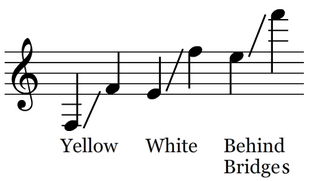
The santur, is a hammered dulcimer of Iranian origins.

The Indian santoor instrument is a trapezoid-shaped hammered dulcimer, and a variation of the Iranian santur. The instrument is generally made of walnut and has 25 bridges. Each bridge has 4 strings, making for a total of 100 strings. It is a traditional instrument in Jammu and Kashmir, and dates back to ancient times. It was called Shatha Tantri Veena in ancient Sanskrit texts.

The gurmi is a two or three-stringed lute of the Hausa people of northern Nigeria. May also be called gurumi or kumbo. In looking at the two-finger playing style used by musicians who play the gumbri, researchers have listed it as a possible relative to the banjo. Researchers have talked about the gurmi and gurumi as if these are two different but similar instruments.



















